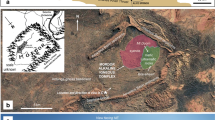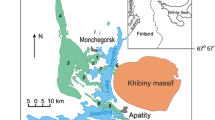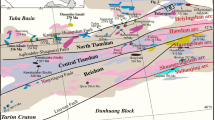Abstract
The Nebo–Babel Ni–Cu–platinum-group element (PGE) sulphide deposit in the West Musgrave Block, Western Australia, is the largest nickel sulphide discovery in the last 10 years. The deposit is hosted within a concentrically zoned, olivine-free, tube-like (chonolithic), gabbronorite intrusion associated with the, approximately, 1,078-Ma Giles Complex-layered intrusions in the Warakurna large igneous province. Emplaced into sulphide-free amphibolite facies orthogneiss, the fault-offset Nebo–Babel chonolith extends for 5 km and has a cross-section of 1 × 0.5 km. Igneous mineralogy, fabrics, and textures are well preserved. The lithostratigraphy includes variably textured leucogabbronorites (VLGN) that form an outer shell around mineralised gabbronorite (MGN), with barren gabbronorite (BGN) and oxide–apatite gabbronorite (OAGN) in the middle and lower parts of the chonolith. Mineral and whole-rock geochemistry indicate that the units become progressively evolved in the order: VLGN, MGN, BGN, and OAGN, and that incompatible trace-element concentrations increase downwards within the MGN and BGN. The mineralisation, which is confined to the early, more primitive units (VLGN and MGN), occurs as massive sulphide breccias and stringers and as disseminated gabbronorite-hosted sulphides. The massive sulphides were emplaced late in the intrusive sequence, have different PGE chemistry and Cu tenor to the disseminated sulphides, and have undergone sulphide fractionation. The distribution of disseminated sulphides, which are primary magmatic in origin, is related to chonolith geometry and magma flow regimes, rather than to gravitational settling. Sulfur-bearing country rocks are absent in the Nebo–Babel deposit area, and thus, local crustal S addition was unlikely to have been the major mechanism in achieving sulphide immiscibility. The Nebo–Babel intrusion is part of an originally continuous magma chonolith with multiple and related magma pulses. The parental magma was medium- to low-K tholeiite with 8–9 wt% MgO. The initial magma pulse (VLGN), the most primitive and sulphide saturated, was probably emplaced along a linear weakness in the country rock. After crystallisation of VLGN, marginally more fractionated, sulphide-saturated magma was injected through the thermally insulated core of the conduit, forming the MGN. Successive pulse(s) of more fractionated magma (BGN) were emplaced in the core of the intrusion. After magma flow ceased, closed system crystal fractionation produced consistent mineral and chemical fractionation trends within BGN and OAGN. After crystallisation, the intrusion was overturned and then offset by the Jameson Fault resulting in the apparent ‘reverse’ chemical and mineral trends in Nebo–Babel.





















Similar content being viewed by others
References
Baker PM, Waugh RS (2005) The role of surface geochemistry in the discovery of Babel and Nebo magmatic nickel–copper–PGE deposits. Geochem Explor Environ Anal 5:195–200
Ballhaus CG (1993) Petrology of the layered mafic/ultramafic Giles Complex, western Musgrave Block, Western Australia. Australian Geological Survey Organization, p 75, Rec 1992/73
Ballhaus CG, Berry RF (1991) Crystallization pressure and cooling history of the Giles Layered Igneous Complex, Central Australia. J Petrol 32:1–28
Ballhaus CG, Glikson AY (1989) Magma mixing and intraplutonic quenching in the Wingelina Hills Intrusion, Giles Complex, central Australia. J Petrol 30:1443–1469
Ballhaus CG, Glikson AY (1995) The petrology of layered mafic–ultramafic intrusions of the Giles Complex, western Musgrave Block, Western Australia. In: Glikson AY (ed) The Giles mafic–ultramafic complex and environs, western Musgrave Block, central Australia. AGSO J Geol Geophys 16:1–2:69–91, thematic issue
Barnes SJ (1986) The effect of trapped liquid crystallization on cumulus mineral compositions in layered intrusions. Contrib Mineral Petrol 93:524–531
Barnes S-J, Maier WD (1999) The fractionation of Ni, Cu and the noble metals in silicate and sulphide liquids. In: Keays RR (ed) Dynamic processes in magmatic ore deposits and their application in mineral exploration. Geol Assoc Can XIII:69–106, short course notes
Barnes S-J, Naldrett AJ, Gorton MP (1985) The origin of fractionation of platinum-group elements in terrestrial magmas. Chem Geol 53:303–323
Bates RL, Jackson JA (eds) (1987) Glossary of Geology. American Geological Institute, p 788
Brown GM (1957) Pyroxenes from the early and middle stages of fractionation of the Skaergaard intrusion, East Greenland. Mineral Mag 31:511–543
Camacho A (2002) Isotopic test of a thermally driven intraplate orogenic model, Australia. Geology 30:887–891
Camacho A, Fanning CM (1995) Some isotopic constraints on the evolution of the granulite and upper amphibolite terranes in the eastern Musgrave Block, central Australia. Precambrian Res 71:735–751
Camacho A, McDougall I (2000) Intracratonic, strike-slip partitioned transpression and the formation and exhumation of eclogite facies rocks: an example from the Musgrave Block, central Australia. Tectonics 19:978–996
Camacho A, Compston W, McCulloch M, McDougall I (1997) Timing and exhumation of eclogite facies shear zones, Musgrave Block, central Australia. J Metamorph Geol 15:735–751
Campbell IH (1978) Some problems with the cumulus theory. Lithos 11:311–323
Clarke GI, Buick IS, Glikson AY, Stewart AJ (1995) Structural and pressure temperature evolution of host rocks of the Giles Complex, western Musgrave Block, central Australia. In: Glikson AY (ed) 1995 The Giles mafic–ultramafic complex and environs, western Musgrave Block, central Australia. AGSO J Geol Geophys 16(1–2):25–40, thematic issue
Cox KG, Bell JD, Pankhurst RJ (1979) The interpretation of igneous rocks. G. Allen, London, p 450
Daniels JL (1974) Geology of the Blackstone Region Western Australia. Bull Geol Surv W Aust 123:257
Glikson AY, Ballhaus CG, Clarke GL, Shearton JW, Stewart AJ, Sun S-S (1995) Geological framework and crustal evolution of the Giles mafic–ultramafic complex and environs, western Musgrave Block, central Australia. In: Glikson AY (ed) The Giles mafic–ultramafic complex and environs, western Musgrave Block, central Australia. AGSO J Aust Geol Geophys 16(1–2):41–69, thematic issue
Glikson AY, Stewart AT, Ballhaus GL, Clarke GL, Feeken EHT, Leven JH, Sheraton JW, Sun S-S (1996) Geology of the western Musgrave Block, central Australia, with reference to the mafic–ultramafic Giles Complex. AGSO Bull 239:206
Goode ADT (1977) Intercumulus igneous layering in the Kalka layered intrusions, central Australia. Geol Mag 114:215–218
Goode ADT, Moore AC (1975) High pressure crystallization of the Ewarara, Kalka and Gosse Pile Intrusions, Giles complex, central Australia. Contrib Mineral Petrol 51:77–97
Gray CM (1978) Geochronology of granulite facies gneisses in the western Musgrave Block, central Australia. J Geol Soc Aust 25:403–414
Gray CM, Compston W (1978) A Rb–Sr chronology of the metamorphism and prehistory of central Australian granulites. Geochim Cosmochim Acta 42:1735–1748
Gray CM, Goode ADT (1989) The Kalka layered intrusion, central Australia: a strontium isotopic history of contamination and magma dynamics. Contrib Mineral Petrol 103:35–43
Hunter RH (1987) Textural equilibrium in layered igneous rocks. In: Parsons I (ed) Origins of igneous layering. Reidel, Dordrecht, pp 473–503
Irvine TN (1982) Terminology for layered intrusions. J Petrol 23:127–162
Kretz R (1983) Symbols for rock forming minerals. Am Mineral 68:277–279
LeMaitre (ed) 2002 Igneous rocks, a classification and glossary of terms, 2nd edn. Cambridge Univ. Press, p 236
Li C, Naldrett AJ (1993) Sulphide capacity of magma: a quantitative model and its application to the formation of sulphide ores at Sudbury. Econ Geol 88:1253–1260
Li C, Naldrett AJ (1999) Geology and petrology of the Voisey’s Bay intrusion: reaction of olivine with sulphide and silicate liquids. Lithos 47:1–31
Li C, Naldrett AJ (2000) Melting reactions of gneissic inclusions with enclosing magma at Voisey’s Bay, Labrador, Canada: Implications with respect to ore genesis. Econ Geol 95(4):801–814
Lightfoot PC, Naldrett AJ (1994) Proceedings of the Sudbury–Noril’sk Symposium. Ont Geol Surv Spec Vol 5:423
Mabuko MAH, Williams IS, Compston W (1996) Zircon U–Pb chronometry of the pressure and temperature history of granulites in the Musgrave Ranges, Central Australia. J Geol 99:675–697
MacDonald GA (1968) Composition and origin of Hawaiian lavas. Mem Geol Soc Amer 116:477–522
Mathison CI (1987) Cyclic units in the Somerset Dam layered gabbro intrusion, southeastern Queensland, Australia. Lithos 20:187–205
McBirney AR, Hunter RH (1995) The cumulate paradigm reconsidered. J Geol 103:114–122
Misra KC, Fleet ME (1973) The chemical composition of synthetic and natural pentlandite assemblages. Econ Geol l68:518–539
Morris PA, Pirajno F (2005) Mesoproterozoic sill complexes in the Bangemall Supergroup, Western Australia: geology, geochemistry, and mineralization potential. Report 99
Myers JS, Shaw RD, Tyler IM (1996) Tectonic evolution of Proterozoic Australia. Tectonics 15:1431–1446
Naldrett AJ (1999) World-class Ni–Cu–PGE deposits: key factors in their genesis. Miner Depos 34:227–240
Nesbitt RW, Goode ADT, Moore AC, Hopwood TP (1970) The Giles Complex, central Australia: a stratified sequence of mafic and ultramafic intrusions. Geol Soc S Africa Spec Pub 1:547–564
Norrish K, Chappell BW (1977) X-ray fluorescence spectrometry. In: Zussman J (ed) Physical methods in determinative mineralogy. Academic, London, pp 201–272
Norrish K, Hutton JT (1969) An accurate X-ray spectrographic method for the analysis of a wide range of geological samples. Geochim Cosmochim Acta 33:431–453
Parsons I (ed) (1987) Origins of igneous layering. NATO ASI series, mathematical and physical sciences v196. Reidel, Dordrecht, p 666
Raedeke LD, McCallum SI (1984) Investigations in the Stillwater Complex: Part II. Petrology and Petrogenesis of the Ultramafic Series. J Petrol 25:395–420
Ripley EM, Alawi JA (1993) Petrogenesis of pelitic xenoliths at the Babbitt Cu–Ni deposit, Duluth Complex, Minnesota, USA. Lithos 21:143–159
Robinson BW, Ware NG, Smith DGW (1998) Modern electron-microprobe trace-element analysis in mineralogy. In: Cabri LJ, Vaughan DJ (eds) Modern approaches to ore and environmental mineralogy. Inter Mineral Assoc Short Course Series 27:153–180
Scrimgeour IR, Close F, Edgoose CJ (1999) Petermann Ranges, N.T. 1:250 000 Geological Series. Northern Territory Geological Survey Explanatory Notes SG 52-7
Scrimgeour IR, Edgoose CJ, Close DF, Wade BP (2005) The Musgrave province—NT’s most underexplored terrane. North Territ Geol Surv Rec 2005–001
Seat Z Geology, Petrology, Mineral and Whole-rock Chemistry, Stable and Radiogenic Isotope Systematics and Ni-Cu-PGE Mineralisation of the Nebo-Babel Intrusion, West Musgrave, Western Australia. PhD dissertation, The University of Western Australia (in prep)
Soffel HC (1991) Paläomagnetismus und Archäomagnetismus. Springer, Berlin Heidelberg New York, p 276
Sun S-S, Sheraton JW, Glikson AY, Stewart AJ (1996) A major magmatic event during 1050–1080 Ma in central Australia and an emplacement age for the Giles Complex. AGSO Res Newsl 17:9–10
Wager LR (1963) The mechanism of adcumulus growth in the layered series of the Skaergaard Intrusion. Min Soc Am Spec Pap 1:1–9
Wager LR, Brown GM, Wadsworth WJ (1960) Types of igneous cumulates. J Petrol 1:73–85
White RW, Clarke GL, Nelson DR (1999) SHRIMP U–Pb zircon dating of Grenville-age events in the western part of the Musgrave Block, central Australia. J Metamorph Geol 17:465–481
Wilson AH (1992) The geology of the Great Dyke, Zimbabwe: crystallization, layering, and cumulate formation in the P1 pyroxenite of the Darwendale Subchamber. J Petrol 33:611–664
Wingate MTD, Pirajno F, Morris PA (2004) The Warakurna large igneous province: a new Mesoproterozoic large igneous province in west-central Australia. Geology 32:105–108
Acknowledgements
We wish to thank all geoscientists, both past and present, from WMC Resources and BHP Billiton, who have been involved in the West Musgrave Project since 1995. This work was built on their considerable effort over many years, in particular, Roland Goodgame, Jim McCluskey, and Libby Fontaine. Recent work by Brett Davis has significantly advanced understanding of the structural history at the Nebo–Babel deposit.
We thank Bill Stone for the initial supervision of the project, Steve Barnes for discussions on trapped silicate–liquid crystallisation, Greg Hitchen for assistance with microprobe analyses, and all the people who provided help at the Nebo–Babel field camp. Dave Burrows and Franco Pirajno are thanked for the helpful and constructive reviews.
Z. S. is supported by an Australian Post-graduate Research Award and a Minerals and Energy Research Institute of Western Australia (MERIWA) Scholarship. Financial support for fieldwork and chemical analyses was provided primarily by WMC Resources and, subsequently, BHP Billiton, as well as MERIWA and a Society of Economic Geologists Grants to Z. S., all of which are gratefully acknowledged. We thank BHP Billiton for permission to publish this paper.
Author information
Authors and Affiliations
Corresponding author
Additional information
Editorial handling: P. Lightfoot
Rights and permissions
About this article
Cite this article
Seat, Z., Beresford, S.W., Grguric, B.A. et al. Architecture and emplacement of the Nebo–Babel gabbronorite-hosted magmatic Ni–Cu–PGE sulphide deposit, West Musgrave, Western Australia. Miner Deposita 42, 551–581 (2007). https://doi.org/10.1007/s00126-007-0123-9
Received:
Accepted:
Published:
Issue Date:
DOI: https://doi.org/10.1007/s00126-007-0123-9




